Strawberries are the fruits of flowering plants of the genus Fragaria, belonging to the Rosaceae family. Usually, they are a bright red color with small green seeds on the outer skin. Strawberries have a sweet, sour taste. Most Strawberry varieties grown in the United States are eaten fresh.
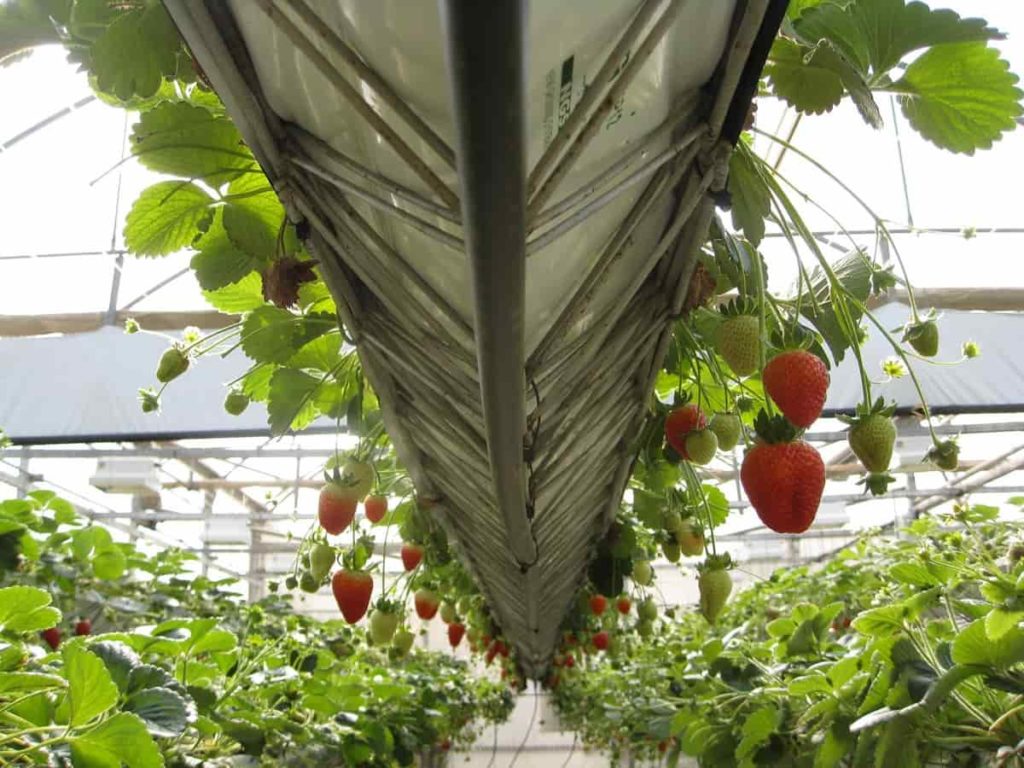
Generally, the price for processing Strawberries is less than half that received for fresh market berries. Almost all Strawberries are used for fresh market sales in Pennsylvania and surrounding states. Let’s check out more information on how to start Strawberry farming in the USA below.
How to start Strawberry farming in the USA
Location for successful Strawberry farming in the USA
Good site preparation is essential for successful Strawberry production. A cover crop and adding enough organic matter to the soil the previous year are the keys to success. Strawberry plants can go almost anywhere. Strawberries are no-picks, from raised beds, containers, and in-ground gardens to those planted in places that need ground cover. They also do not grow very deep roots.
So if you can find space for any container or designate an area of the garden, you can probably grow Strawberries there. Most Strawberry plant varieties do best with lots of sun, so ensure your plants get plenty of sun. Also, make sure you choose hardy varieties for your area and double-check their care requirements because not all varieties have the same growing conditions that can be applied.
Tips for growing Strawberries in the USA
- Consider overwintering Strawberry pots – The process of moving Strawberries indoors is to protect them from cold weather in the winter. A shed or unheated garage will do. If you plan to overwinter your Strawberry plants, plant them in pots or hanging baskets so they’re easy to move at the end of the growing season. Give your potted Strawberry plants extra winter protection by insulating them. Wrap them in burlap and stuff straw mulch between the burlap and the pot. Cover the top of the plant with six to eight inches of straw.
- Keep the Strawberry runners – Runners are shoots that produce new plants. As runners develop, decide whether to keep, remove, or spread them. Place the runners where you want the daughter plants to grow and gently press the ends into the soil to encourage rooting. You can also transplant daughter plants by placing a pot full of soil next to the mother plant and allowing the runners to take root there.
- Remove the flowers first – To encourage your Strawberries to put their energy into developing roots and shoots, cut off the flowers first. For June-bearing Strawberries, remove flowers the entire first year to ensure healthy plants for the following year. For other varieties, you can pinch off flower buds for the first four weeks and harvest Strawberries later in the season.
- Weed regularly – Strawberries have trouble fighting weeds, so keep your Strawberry patch weed-free with frequent hand weeding and mulching.
In case you missed it: Top 20 Steps to Boost Strawberry Yield: How to Increase Strawberry Production
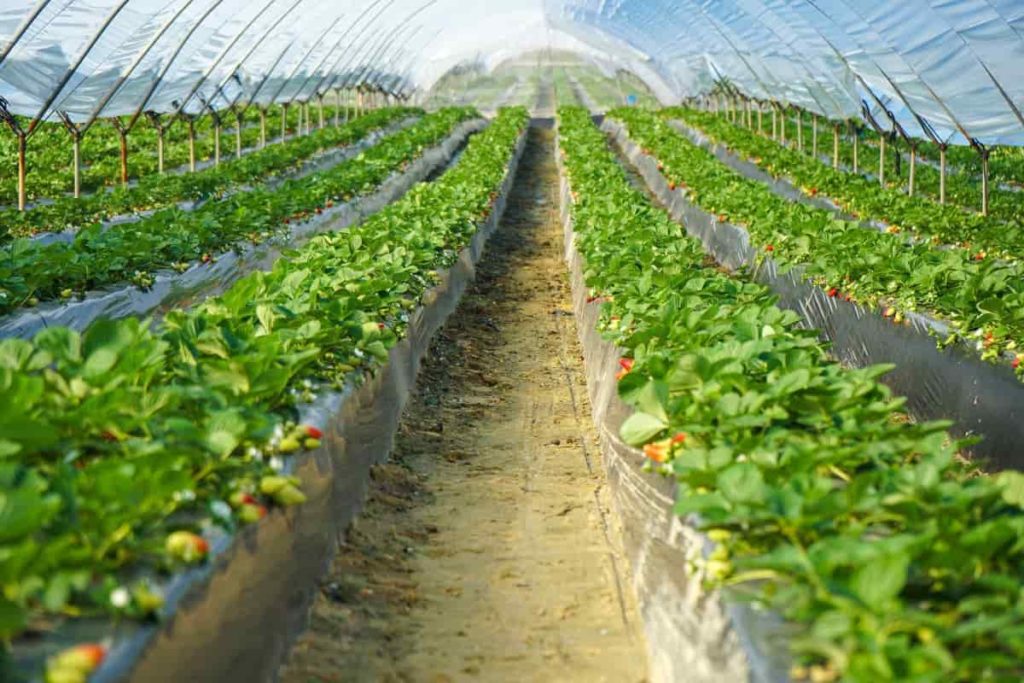
Strawberry growing states in the USA
The major Strawberry states grown in the United States are California, Florida, North Carolina, Wisconsin, and Pennsylvania. The Strawberry industry in the US is always booming, so it’s no surprise that many farmers are interested. In all places, it’s possible to grow these delicious and healthy berries successfully. For example, if you are in other states like Idaho, Michigan, and Nebraska, greenhouses are beneficial for growing Strawberries.
Strawberry growing methods
Growing from seed
However, garden Strawberries are hybrids, and there’s no guarantee that you’ll get the Strawberry characteristics you love. Some seed companies offer Strawberry seeds for alpine varieties and some heirloom varieties, so if you’re planning a large Strawberry garden, this can be an economical way to get started. It also grows well from seed, but it takes a long time. You can save your favorite Strawberries, wait until they’re mushy, collect and dry the seeds, and plant them indoors in early spring.
Growing from a Starter
In mild climate conditions, Strawberry crowns can be planted in the fall, dormant over the winter, and sprouted in the spring. But in locations where the ground freezes, they are best planted in early spring. The different growth habits of Strawberries determine how they should be planted. June plants that produce more stolons can be planted in early spring with plenty of space between mother plants (18-24 inches apart, 36-48 inches apart in rows).
It is called mated row production and works well with disease-resistant varieties. Ensure pinching back flowers in the first year after planting to prioritize vegetative and stolon growth. Planting Strawberries in high rows or mounds can help them avoid rotting in overwater, resist frost, and keep diseases at bay by providing good air circulation around the plants.
The University of Oregon Extension recommends this process for day-neutral varieties, as they produce fewer stolons, and recommends planting 2-3 rows of plants 12-15 inches apart with 2 feet of space between them. If you plant June varieties like this, you must trim the stolons whenever you see “daughter” plants. Whether you grow Strawberries from seed or purchased starts or dormant crowns, plant Strawberries so that the crown base is level with the soil, it ensures that the roots do not dry out and that the stems and leaves can grow freely.
Where do Strawberries grow best in America?
California, Florida, North Carolina, Wisconsin, and Pennsylvania states are ideal places to grow Strawberries in the United States. However, the top two, California and Florida, will be among the best. If you are from another state, you can also use a greenhouse, creating a perfect growing environment for a productive Strawberry farm. California is responsible for 75% of the production. Fruits are available from January to November, with peaks from March to May.
The state can produce a billion pounds of berries yearly; each acre averages 21 tons annually. California is followed by Florida, where the Strawberry season runs from December to May. It peaks from March to April, and the state imports winter Strawberries from November to May. This way, the state can meet the demand for Strawberries throughout the year. The largest producer of Strawberries in the United States of America, which grows 20-25 percent of the world’s annual production.
California dominates US Strawberry production. The state’s annual harvest consistently reaches nine-tenths of all US Strawberries. Most Strawberries are grown in the state’s southwestern counties (especially along the coast), where the full sun and a mild climate dominate. With 8 to 9% annually, the second largest Strawberry producer in the United States is Florida. Plant City is the center of Strawberry farming for the state.
Most of the Strawberries sold in American grocery stores during the winter (especially in December and January) come from Florida. Together, California and Florida account for more than 95% of all Strawberries in the United States. These states’ mild winters allow farmers to use hill cultivation on Strawberry farms.
In case you missed it: How To Start Strawberry Gardening, Tips, Ideas
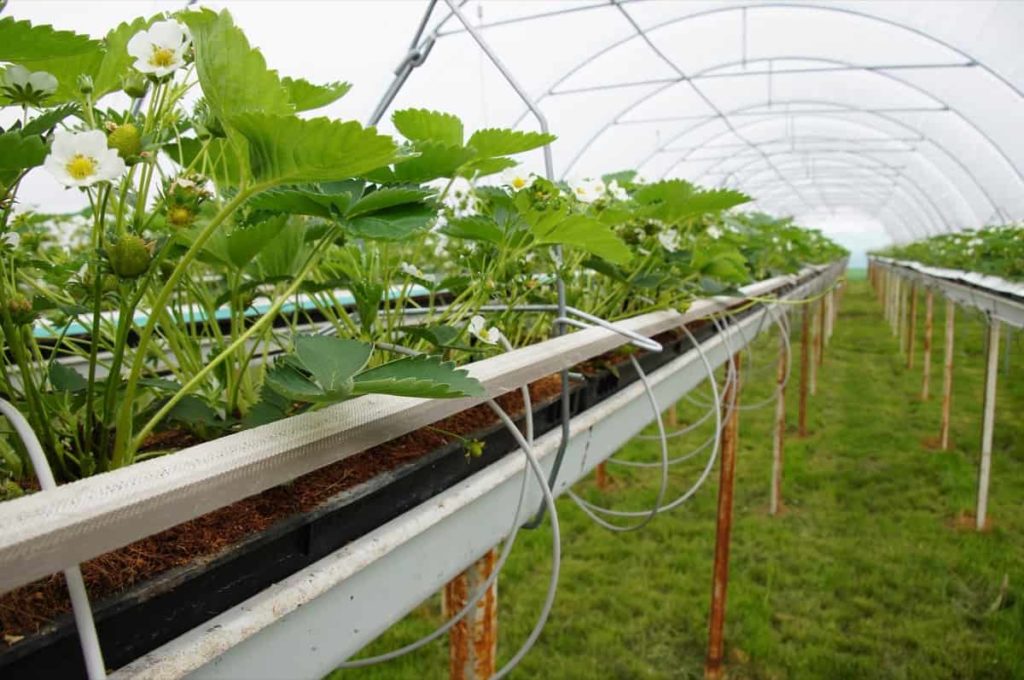
Best Strawberries in the USA
Remember that there are three types of Strawberries: June-bearing, ever-bearing, and day-neutral—choosing among the three means considering certain factors. For commercial production, June bearing is most common in the US because they produce larger fruits and have many runners. This variety can bear fruit for up to two weeks, making it more productive than other varieties. In contrast, the evergreen Strawberry only bears fruit three times a year.
Day-neutral Strawberries will be abundant from July to September, but maintaining ideal temperatures is critical as this can affect their flowering. Considering greenhouses, you can have a long growing season at a minimal cost. You don’t have to deal with potential outdoor fluctuations in climate, and the extended season helps you get a higher price for your Strawberries. As a bonus, you’ll always be confident in the quality of your berries, considering that the weather affects their flavor.
It is important to have a constant supply of high-quality Strawberries to make them easy to sell. Some stores also require good quality, so don’t waste all your hard work settling for so-so fruit quality. June-bearing Strawberry varieties bear fruit all at once, usually over three weeks. Sensitive to day length, these varieties produce buds in the fall, flowers and fruit the following June, and runners in the long summer days. Although known as “June bearing” or “June bearers,” these Strawberries bear before June in warmer climates.
Most common Strawberry varieties in the USA
June-bearing Strawberries are the most common in the United States.
- Chandler: A high-yielding June Strawberry with a classic conic fruit, Chandler is relatively tolerant of hot climates.
- Earliglow: One of the early-season Strawberry crops in June, ‘Earliglow’ plants produce medium-sized fruits that are firm and hardy.
- Honeoye: These June-bearing Strawberry plants produce their crops earlier in the season than others. Bright red and glossy, ‘Honeoye’ Strawberries can be susceptible to many plant diseases, making them less suitable for novice home gardeners.
- Sparkle: A June-hardy Strawberry plant, Sparkle produces bright red, medium-sized fruit with a sweet flavor. They are especially popular for jams, jellies, and desserts and freeze well.
Best site and climate for Strawberry farming in the USA
California supplies more than 90% of the US’s Strawberries, and that percentage is expected to grow. One reason is the state’s Mediterranean climate with hot, dry summers and mild, wet winters. Year-round mild temperatures with sunny days and cool, humid nights create perfect conditions for growing Strawberries. Unlike Florida, the second largest Strawberry-producing state in the US, where berries can be harvested between March and November, California has a 12-month growing season.
The climate and growing season make California’s fields highly productive. About 75% of all California Strawberries are harvested for the fresh fruit market each year, and 25% are frozen for the processed fruit market. Grow Strawberries in a full-sun location with at least 8 hours of sunlight. Make sure the planting site has good drainage. Before planting, mix two pounds of compost with nitrogen, phosphorus, and potassium per 10 feet of soil.
Use transplants for Strawberry planting; bare root transplants are the most common, but you can also find container transplants in plastic trays at garden centers. Many people plant Strawberries in raised beds with black plastic mulch to control weeds and keep soil off the berries. Set your transplants through the silt in the mulch. Make sure you don’t cover the crown of the transplants.
Strawberry planting and care in the USA
Planting times for Strawberries will change depending on where you are in the state. North Florida gardeners can plant between September 15 and October 15, Central Florida between September 25 and October 25, and South Florida gardeners between October 1 and December 1. Purchase transplants from local garden centers in late fall or early winter and plant them 10 to 18 inches apart. You can plant them on the ground, in raised beds, or in containers.
For best results, pot plants in rich soil or potting media, water them often, and fertilize regularly with a balanced fertilizer. Covering the plants with a light blanket will help protect the flowers or fruit from damage if a frost is forecast. The first berries must be ready to pick about 90-110 days after planting. If you have trouble with rabbits or birds stealing fruit, try using netting to protect the plants.
In case you missed it: Strawberry Farming Project Report, Cost, Profit Guide
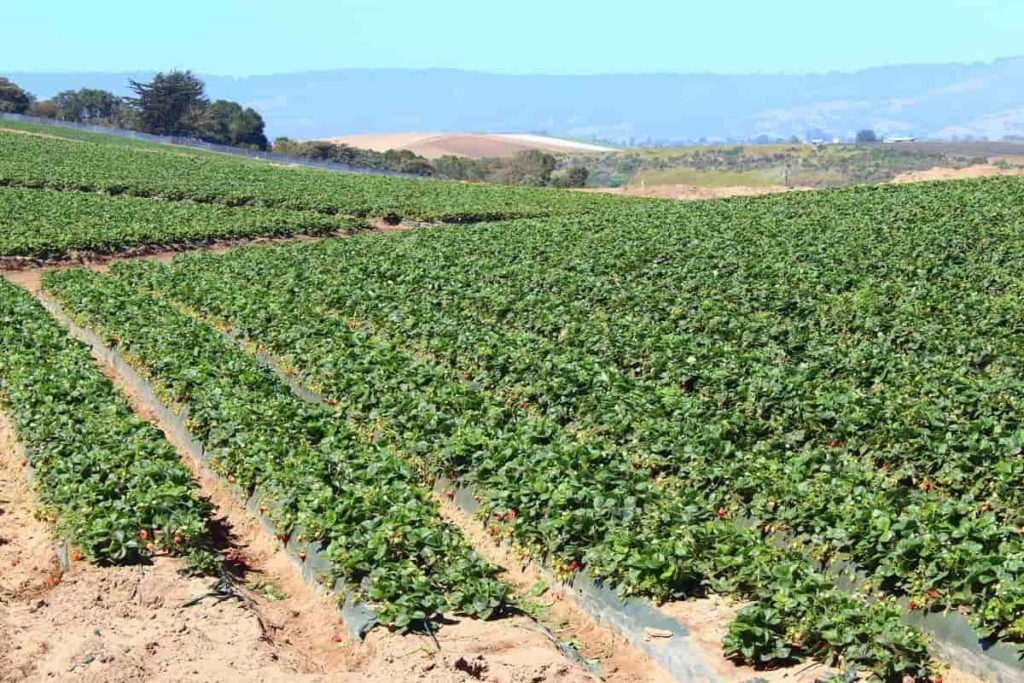
Pick the berries when at least three-quarters of their surface is red. Once picked, the berries will no longer be sweet. Freshly picked Strawberries usually only keep for a few days, so be sure to eat them right after picking. If you have more berries, you can freeze them.
Watering for healthier plants and better yields
For Strawberries, about 1 inch of water per week is a general rule of thumb; your irrigation will vary depending on your soil type, temperature, and humidity. Do not let the soil soak, as the crowns will rot, but Strawberries are susceptible to water stress because of their shallow roots and should not be allowed to dry out, especially when producing fruit.
Drip irrigation is the healthiest method and conserves water, and it allows you to set up fertigation – a system of distributing liquid or dissolved soil amendments through irrigation. Micro-sprinklers save water and produce healthier plants and better yields.
Strawberry acreage in the USA
About 60,000 acres in the United States are devoted to growing and harvesting Strawberries, with California accounting for 38,200 acres. California’s oldest Strawberries are grown in Orange, Los Angeles, and San Diego counties, where the harvest is from January to May, with the peak season in April.
The Oxnard area (Ventura County), known for its Strawberry Festival, produces fresh Strawberries from January through June. Northern areas, such as Monterey, San Benito, Santa Clara, and Fresno counties, begin shipping in April, while the peak season is in May and June.
Strawberry market size in the USA
The United States produces more than 1.6 billion pounds of Strawberries annually, valued at approximately $3.5 billion. The market value of Strawberries in California is estimated at $2.34 billion. It ranks among the valuable crops in the state, along with dairy, grapes, almonds, cattle and calves, and pistachios.
Good marketing also plays a role in market size. The California Strawberry Commission launched a “Snack with Heart” marketing campaign to encourage consumption and connect the hearts of farmers with the hearts of consumers. Using social media and digital media with influencer partnerships, the marketing campaign highlights the health benefits of California Strawberries to increase consumption.
Pest and disease management
Many insects and diseases can damage the crop. Therefore, it is important to monitor and control pests. Some insects attack flowers and fruits, while others attack plant foliage, stems, crowns, and roots. Pest management involves many aspects of production, pesticide application being only one. Learn to accurately identify pests, incorporate scouting into your routine to catch problems early, and familiarize yourself with pest biology.
Many pest problems can be avoided or prevented by proper site selection, crop rotation, proper planting timing, and the use of disease-free seeds or plants. Birds can be a serious problem on Strawberry farms. Crop protection may require netting, chemical repellents, scare tactics, and noise devices. Deer can also cause extensive plant damage by trampling and eating plants and ripening berries. Hunting, fencing, and repellents can all reduce deer damage.
In case you missed it: Strawberry Farming; Planting; Growing; Care; Harvesting
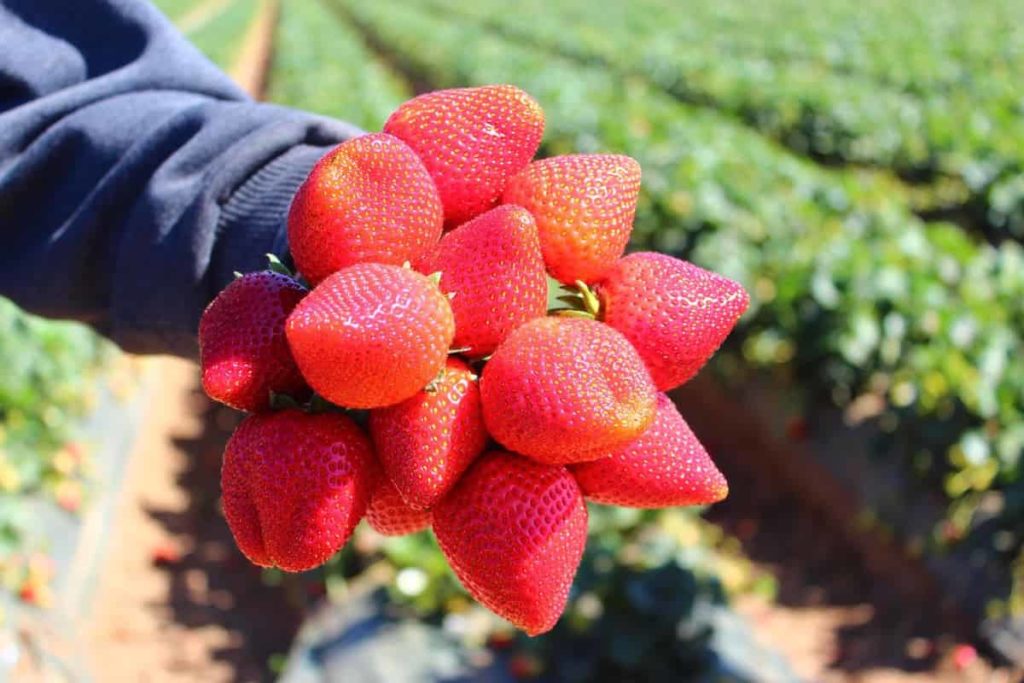
Weed control is important, as Strawberries have shallow root systems that damage them when they compete for water and nutrients. Weed problems can be reduced by avoiding areas with persistent weeds and removing weeds before planting. Once established, herbicide application and shallow cultivation can control weeds in plants, but consistency is required. Few herbicides are available for Strawberry plants, but if used properly and cultivated by hand and machine when chemical control cannot be used or fails, Strawberry cultivation is very profitable.
Healthy transplants are an excellent defense strategy to avoid diseases and pests when growing Strawberries. Buy plants from reputable nurseries or garden centers. Most foliar, flower, or fruit diseases can be controlled with fungicides for home garden use. Be sure to remove dead and diseased plant leaves to reduce infection. Control powdery mildew with sulfur applications. Please ensure the temperature is cooler than 80°F before applying sulfur; otherwise, it will cause burns on fruits and plants.
Pests on Strawberry plants will change with the seasons. Caterpillars, Aphids, and thrips are found early in the season in Strawberries. Spider mites are a persistent pest in Strawberries – look for them around December. Nematodes and soil-borne diseases can cause problems if you plant Strawberries in the same spot yearly. Vary your planting areas, and avoid planting Strawberries in areas where tomatoes, eggplants, or other vegetables susceptible to Verticillium wilt have just been planted.
Which US state produces the most Strawberries?
In the United States, fresh Strawberries are grown primarily in California (about 90 percent annually), Florida (about 8 percent), New York, North Carolina, Oregon, and Washington.
When to harvest Strawberries
When about three-quarters of the Strawberry’s surface is red, it’s time to pick it! Leaving part of the green stem attached will help the berries last longer. Strawberries stay fresh for a few days after picking, so eat them soon or add them to your favorite recipes. If you don’t think you’ll have all of your delicious Strawberries within a few days of picking, you can freeze them for later use.
Strawberry yield per acre in the USA
The United States planted 43,400 acres of Strawberries. The average Strawberry yield per acre was 50,500 pounds, ranging from 68,000 pounds per acre in California to 3,200 pounds per acre in New York. The large range between yields per state is due to differences in climate.
In case you missed it: Blueberry Farming in USA: How to Start, A Step-by-Step Guide for Beginners
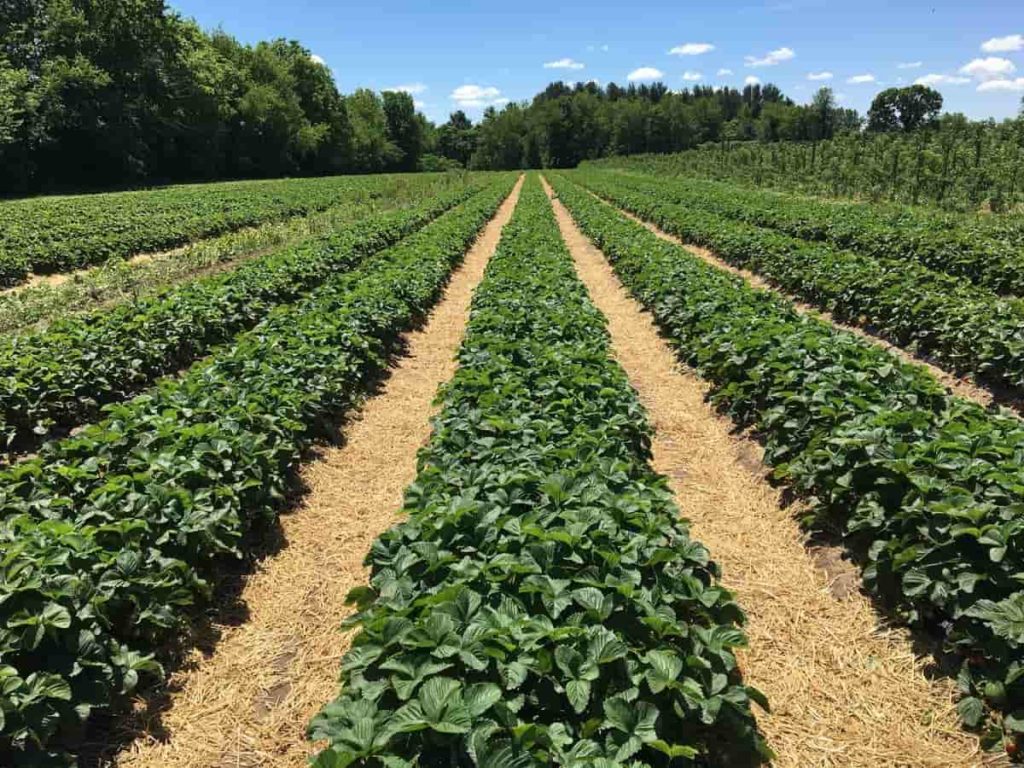
California has a temperate climate, allowing for a 12-month growing season and higher yields per acre than other states. Other states’ climates limit the growing season to an average of five months, with some areas having a growing season as short as three weeks (California Strawberry Commission).
Conclusion
Strawberries are one of the easy-to-grow fruits and are great for beginners. The taste is far more flavorful than anything you’ll ever find in a grocery store. According to Pennsylvania State University, the United States is the number one producer of Strawberries globally, with 60,000 acres grown in the country.
- Types of Pesticides Used in Agriculture: A Beginner’s Guide
- Economical Aquaculture: A Guide to Low-Budget Fish Farming
- 15 Common Planting Errors That Can Doom Your Fruit Trees
- How to Make Houseplants Bushy: Effective Tips and Ideas
- Innovative Strategies for Boosting Coconut Pollination and Yield
- Pollination Strategies for Maximum Pumpkin Yield
- The Complete Guide to Chicken Fattening: Strategies for Maximum Growth
- Natural Solutions for Tulip Problems: 100% Effective Remedies for Leaf and Bulb-Related Issues
- Revolutionizing Citrus Preservation: Towards a Healthier, Greener Future
- Natural Solutions for Peony Leaf and Flower Problems: 100% Effective Remedies
- Maximizing Profits with Avocado Contract Farming in India: A Comprehensive Guide
- Natural Solutions for Hydrangea Problems: 100% Effective Remedies for Leaf and Flowers
- The Ultimate Guide to Choosing the Perfect Foliage Friend: Bringing Life Indoors
- From Sunlight to Sustainability: 15 Ways to Use Solar Technology in Agriculture
- The Ultimate Guide to Dong Tao Chicken: Exploring from History to Raising
- The Eco-Friendly Makeover: How to Convert Your Unused Swimming Pool into a Fish Pond
- Mastering the Art of Delaware Chicken Farming: Essentials for Healthy Backyard Flocks
- 20 Best Homemade Fertilizers for Money Plant: DIY Recipes and Application Methods
- How to Craft a Comprehensive Free-Range Chicken Farming Business Plan
- Brighten Your Flock: Raising Easter Egger Chickens for Beauty and Bounty
- How to Optimize Your Poultry Egg Farm Business Plan with These Strategies
- Subsidy for Spirulina Cultivation: How Indian Government Schemes Encouraging Spirulina Farmers
- Ultimate Guide to Raising Dominique Chickens: Breeding, Feeding, Egg-Production, and Care
- Mastering the Art of Raising Jersey Giant Chickens: Care, Feeding, and More
- Ultimate Guide to Raising Legbar Chickens: Breeding, Farming Practices, Diet, Egg-Production
- How to Raise Welsummer Chickens: A Comprehensive Guide for Beginners
- How to Protect Indoor Plants in Winter: A Comprehensive Guide
- Ultimate Guide to Grow Bag Gardening: Tips, Tricks, and Planting Ideas for Urban Gardeners
- Guide to Lotus Cultivation: How to Propagate, Plant, Grow, Care, Cost, and Profit
- Agriculture Drone Subsidy Scheme: Government Kisan Subsidy, License, and How to Apply Online
- Ultimate Guide to Raising Araucana Chickens: Breed Profile, Farming Economics, Diet, and Care
- Bringing Hydroponics to Classroom: Importance, Benefits of Learning for School Students
- Ultimate Guide to Raising Polish Chickens: Breed Profile, Farming Economics, Diet, and Care
- Ultimate Guide to Raising Australorp Chickens: Profile, Farming Economics, Egg Production, Diet, and Care
- Silkie Chicken Farming: Raising Practices, Varieties, Egg Production, Diet, and Care
- Sussex Chicken Farming: Raising Practices, Varieties, Egg Production, Diet and Care